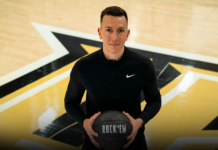University of Central Florida senior and innovator, Michael Artime, spoke to his fellow students on Thursday about planning and researching before starting a business in the Blackstone Launchpad.
Artime started online marketing at the age of 19 and over time created software. He ran this business up to six figures in less than three months, but sold the business to focus on his own tech start-up, MobiCatch.
In simple terms, MobiCatch is an app that will work to connect people and businesses and draw them closer together.
Just like most entrepreneurs, Artime admitted that he had failed numerous times.
“People will learn more from their failures than from their successes. I failed a bunch of times and there are people that have failed a lot more than I have, and they’re successful now,” said Artime.
Artime pointed out that one of the biggest mistakes people make when they think they have an idea for a business is to put money into it and start marketing it right away.
Before thinking about money or even the name of your future business, Artime suggests first going through an extensive process that he has dubbed the “grind hub.” The process is as follows.
Define
During the first stage of the process, Artime advised that you should figure out exactly why you are doing this and what your vision is. Then, try to form a 1-2 sentence statement describing your idea.
“This is the most important thing. If you can knock this out, that’s huge,” said Artime.
Market
Next, determine what your market is and why people would want to use your product. There are three types of addressable markets: potential, total and target.
When Artime was making his grind hub, he literally drew out a stick person, gave him a name and then listed demographic characteristics about this fictitious person. This person is his potential new customer.
Lastly, list all the problems and solutions within your market. Artime gave the example of a problem being the long line that is always at Chipotle. A solution to this would be an app that tells the approximate wait times.
Competition
Competition is usually one of the first things someone with a new idea researches. Most of these people are discouraged when they find that something similar to their idea has already been invented, but Artime said that you shouldn’t just give up.
There are different features to products and you may be able to offer a different feature or multiple features as opposed to the competitor. In order to figure out what these features are, a detailed list needs to be made.
Once you have all the competitors listed, figure out how you’re different or better than them. A more extensive analysis can be made for each competitor about how fast they grew or where they started so that you can reference back to that later in your process.
Revenue Model
The revenue model is pretty straight-forward. For this stage, you will research different ways that your business can make money and figure out which one you think will work the best. You can also reference the extensive competitor analysis in the previous stage to help.
Feature Set
The feature set is where you will draw out everything that you want to see. In Artime’s case, he drew out all the pages of a software program he wanted to create. You should do this before you spend anytime on a designer or a programmer.
Drawing everything out will also save time and help the designer in the future to see your vision, which in turn, helps the programmer.
Growth Strategy
Last is the growth strategy. This is the stage when you have to think about how your product will grow to reach customers. First, start by figuring out how you are going to reach you very first or second customer.
Whenever you feel stuck, look back to your competitor analysis to draw inspiration and see how your competitors went about establishing customers.
This is also the stage when you can start thinking about the name of your business, the domain, how much money you need from investors, etc.
This process can take months to complete, but that shouldn’t discourage you. Artime said that doing this process will really let you determine whether your product is a good idea or not. Also, this information is exactly what investors will be looking for when you ask them for money.
Jake Thomas came to the speaking event to learn more about start-ups and business marketing.
“I feel like he [Artime] knows what he’s doing. I’ve heard numerous times that you’ll fail many times, but it’s all about how you take that failure, just like he pointed out,” said Thomas.
One of Artime’s best pieces of advice was to surround yourself with people who believe in you and people that you want to be like, like friends and mentors.
“If your five best friends a millionaires, you’re not just going to stay poor. You’re going to figure out how to be a millionaire like them,” joked Artime.
Artime plans to graduate this May and then travel to the Silicon Valley for a month. He’ll just be “winging it” there while also raising funds for MobiCatch.






